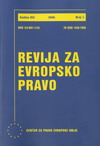REŽIM ODGOVORNOSTI ZA ŠTETU U ŽIVOTNOJ SREDINI U PRAVU EVROPSKE UNIJE - OSVRT NA DIREKTIVU 2004/35 O ODGOVORNOSTI ZA ŠTETU U ŽIVOTNOJ SREDINI
ENVIRONMENTAL DAMAGE LIABILITY REGIME UNDER THE EU LAW: REVIEW OF THE ENVIRONMENTAL LIABILITY DIRECTIVE 2004/35
Author(s): Zoran SretićSubject(s): Politics / Political Sciences, Politics, Law, Constitution, Jurisprudence, Environmental and Energy policy, EU-Legislation
Published by: Удружење за европско право - Центар за право Европске уније
Keywords: environmental damage; damage to protected species and natural habitats; water damage; land damage; natural resource; natural resource services; strict liability regime; fault based regime
Summary/Abstract: The Author of this text delivers an overview of the EU liability regime for environmental damage through analysis of provisions of Directive 2004/35. Starting from the hypothesis that legal concept of protected good determines adequate legal path of its protection, he recognizes that the liability regime for environmental damage is contingent upon EU legislator’s legal understanding of environment as a public good. Therefore, the Directive institutes public law concept of environmental damage complemented by public law liability which has to be established under administrative procedure. As a primary characteristic of the Directive, the author, hence, distinguishes its conceptual division with tort law appreciation of damage which is elaborated under Lugano Convention, as well as under domestic Law on Environmental Protection that leans upon Law on Contracts and Torts. On the other hand, he notices that, although liability for environmental damage is being established under administrative procedure in accordance with the Directive, criteria for its establishment are based upon concepts of strict liability and fault-based liability of civil/tort law. Nevertheless, unlike civil law approach where protection is conditional upon private initiative and where object of protection is of proprietary nature, here the liability is determined under administrative procedure which is initiated by competent authority acting as guardian of public interests in relation to an imminent threat of environmental damage with significant adverse effects or environmental damage with significant adverse effects to the natural resources and/or natural services. As natural resources and natural services cannot be valued by market criteria, the problem of their market valuation in fact, does not occur, as the scope of liability is measured through financial coverage of restoration costs for harmed natural resources and/or their services into baseline condition by liable operator in accordance with ′polluter pays′ principle. Therefore, the author concludes that the separation of environmental damage from the civil law concept of damage will create the risk to the potentially liable person of being financially burdened under two separate legal grounds (public law and private law) as a result of a single episode, which will provide policy background to effectively direct the operators’ behavior towards ultimate model of every legal system of compensation - better safe than sorry.
Journal: Revija za evropsko pravo
- Issue Year: 8/2006
- Issue No: 2-3
- Page Range: 39-66
- Page Count: 28
- Language: Serbian

